Sustaining Momentum in The New Golden Age of Trails
Trail development is alive and well in what some are aptly calling "The New Golden Age of Trails."
Foreward by Daniel Sapp: Kristian Jackson is based in Boone, NC, and brings a wealth of mountain biking expertise from his experiences on the trail and in the classroom. As a Senior Examiner for the Professional Mountain Bike Instructor Association, the Trail Boss at Rocky Knob Mountain Bike Park, and Senior Lecturer in Recreation Management at Appalachian State University, he combines his knowledge from a myriad of unique experiences in all aspects of his career.
If you are a mountain biker today, you are likely experiencing the golden age of riding. Bike technologists are advancing bikes' capacity to deliver fun, and trail development follows this pace with ever-increasing interpretations of how to build amazing experiences out of dirt, stone, and wood. New trails are in demand, and it seems everyone wants in.
"There hasn't been a time like this since the first golden age of trails," says Jason McDougal, Executive Director of Camp Grier and the G5 Trail Collective. The G5, as it is known, is a non-profit trail advocacy organization helping push the stewardship needle in western North Carolina. That golden age was the 1930s when the Civilian Conservation Corps (CCC) employed about 3 million young men to help lift the nation out of the Great Depression.
At the time, our public National Forest lands were a new idea for our nation. The CCC assisted with creating natural resource infrastructure roads, bridges, campgrounds, and trails. The organization also raised public interest in our shared public lands.
In western North Carolina, these crews witnessed first-hand the cumulative environmental damage of unchecked timber harvesting. They saw the clearcuts, the steep terrain, and the erosion that would dump silt into the rivers. These crews honed their sustainable stewardship techniques and left a legacy of fine singletrack trails, like the historic Holly Springs, as well as the recipe for how to build them.
While the CCC created valued infrastructure here in Western North Carolina (WNC), it couldn't fix all the environmental issues on public lands. Once the nation entered WWII, their work and organized governmental attention to trails ended. The momentum of sustainable stewardship slowed, budgets for public lands evaporated, and the trails of WNC languished for decades in the folds of the ridges.
But today, this is no longer true. Thanks to the diligent work of numerous volunteer groups that have increased their level of sophistication in their advocacy. Trail system analysis, grant writing, paid executive directors, and critical partnerships have resulted in more new trails, and trail maintenance of those that already exist, than ever seen on public lands in WNC. Over 50 miles of new singletrack trails are either on the ground or set to open over the next three years. But the critical question is – is this momentum sustainable? The G5 Trail Collective says yes and they are actively building the connections to back the momentum. Case in point: the Newberry Creek Trail in the Grandfather District of Pisgah National Forest.
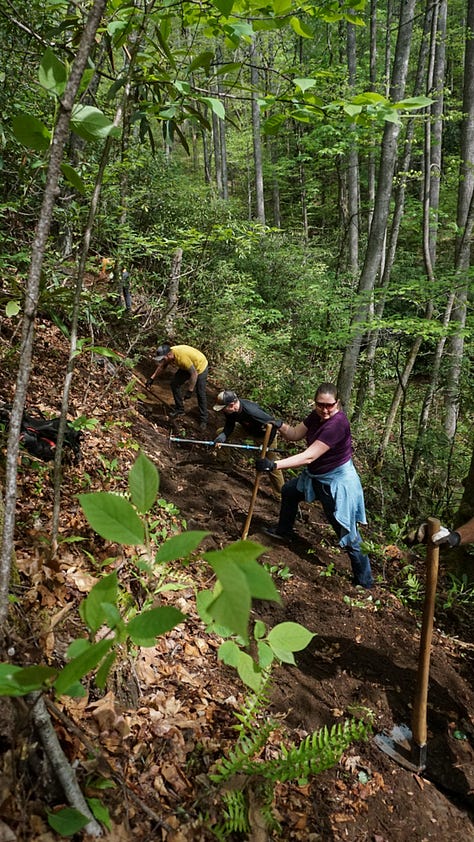

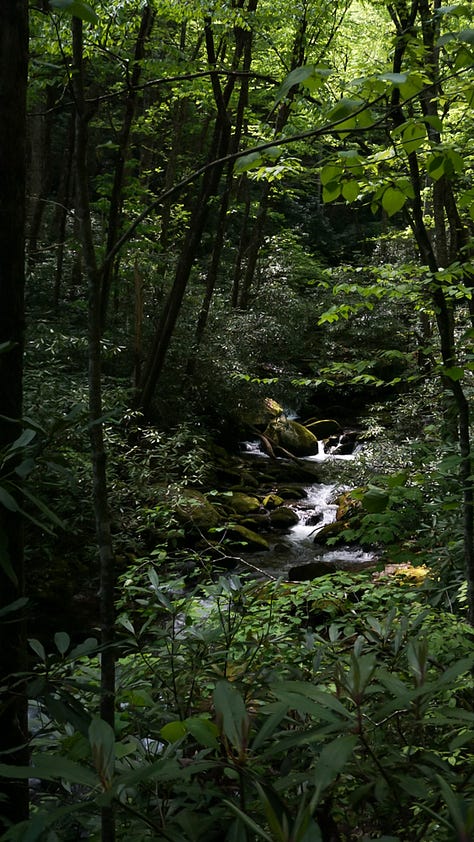
Pisgah National Forest contains three distinct districts – the Pisgah District near Brevard, the Appalachian District north of Asheville, and the Grandfather District, which spans from Old Fort to Blowing Rock and is home to the first tracks of public forest land in the east as well as the steepest escarpment, which Newberry Creek descends.
The Newberry Creek Trail is one component of the G5's comprehensive master plan to create 42 miles of new trail in the Grandfather District of Pisgah National Forest. The trail is currently a hike-only trail that follows a high-elevation watershed on the flanks of Mt. Mitchell, the east's highest peak. Part of the G5's plan includes the USFS re-designating the trail as hike and bike to allow riders to access the classic Heartbreak Ridge, the new Lower Heartbreak, and the yet-to-be-created most difficult trail off Glass Rock Knob. This connection opens a missing link of trails that avoid long gravel fire roads and double-track grinds. The trail follows the creek, and with the sedimentation concerns that come with increased bike traffic, the plan is to reroute parts of the trail for better sustainability. The new trail sections are to be handbuilt – not for environmental sustainability – but for social sustainability.
In the era of the CCC, trail development followed the tenets of environmental sustainability – the trail should keep users on it and have as little impact on the surrounding land as possible. In recent years, the idea of the triple bottom line has been incorporated into trail development. Sustainability can only happen if it checks out to be good environmentally, economically, and socially. Simply put, trails should not erode too quickly, and they should meet the needs of the users while providing economic benefits to surrounding communities, many of which have been struggling due to industry changes in the previous decades.
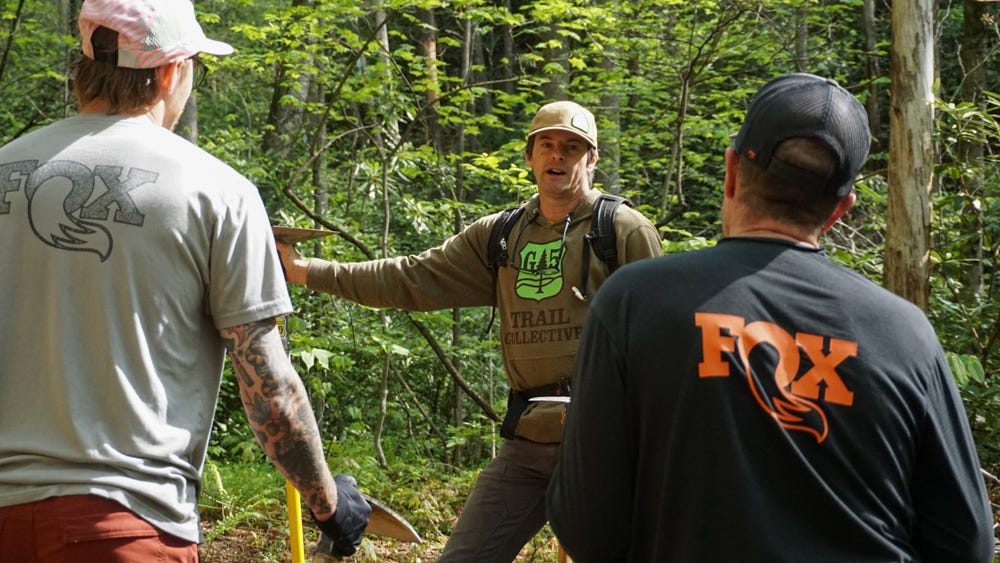
The G5 has used Newberry Creek to engage specific community members with volunteer work that would result in "skin in the game," a kind of public awareness of trails akin to the first golden age with the CCC. People know about the trail, know about trail work, find value in the process, and spread their appreciation of the process to members of their communities, which in turn gets more and more people involved. It's an exponential marketing arrangement - getting the right people to get engaged to get even more people engaged…and it’s working. The G5 has created the template for this by hiring a full-time trail director and volunteer coordinator to multiply their impact and bring more and more resources to the trails near Old Fort.
Through a series of conversations, the G5 engaged with corporate members of the bike industry, not for financial support, but for some sweat equity. Fox Factory’s Eastern Suspension Service Center is located just a few miles away in Asheville, NC. Their team stepped up for a weekend of labor, camping, and riding for Newberry Creek. The idea here was to establish a connection that would first get the job done but also have the added benefit of a long-term social impact.
Engaging the public to assist with trail projects isn't new. Still, it is an essential link in the recipe for sustainable trails. "When we work with Fox and others in the bike industry, they are influencers. They bring clout to the project," says McDougall. They help set the tone for the larger community. It's like saying, 'The trail is important enough to give a whole weekend.'" Trail work is a perfect connection between giving to and receiving from.
"Mountain biking has given me so much over the years," says Brian Chryst, Fox Factory Service Specialist. "Everything from physical and mental wellbeing to shaping my life decisions on where I live and the people I meet. Being a trail volunteer, in my opinion, is just the best way I can repay the trails that have already done so much for me.”
"What many don't consider," says Kevin Booth, Service Manager for Fox Factory East, "is the fact that you also get to take something for yourself in the form of the pride and ownership that you feel as you get to put a shape to something that you and others will enjoy for a long time. It's a legacy thing. I swear I ride a little better on sections of trail that I've helped to build and maintain."
Important for this trail project is a “new” trail construction style. Under the guidance of G5's Trail Director Jon Lane, the crew learned how to create a narrow, bench-cut trail the same way the CCC would have done it 90 years ago. "It's a lot of work," says Steffen Gronegger, Fox Operations Specialist. "But the culture this is creating is incredible. We're out here, deep in Pisgah, handbuilding a new trail. There's nothing like it." The final product of a handbuilt trail has a “feel” that’s distinct from a machine-built trail. It’s a palpable intimacy with the land.
On the surface, hand-building trails is an act of creating something that doesn't exist, and there is a special connection between generations. That is the core of social sustainability: a motivation to invest oneself in the well-being of others.
"We're building a community of stewards here," says Jason McDougall. "We're planting trees that others will sit under long after we are gone. It truly is a golden age for trails."
At the end of the day, the Fox crew established a new trail that will be a tiny fraction of what is needed to complete G5's goals. However, the measure of trail work isn't linear feet. The measure of a trail is more about creating an experience that inspires a closer connection to the land. This is how to sustain momentum, and it’s exactly what is happening all across Pisgah and in many other areas experiencing “The New Golden Age of Trails.”


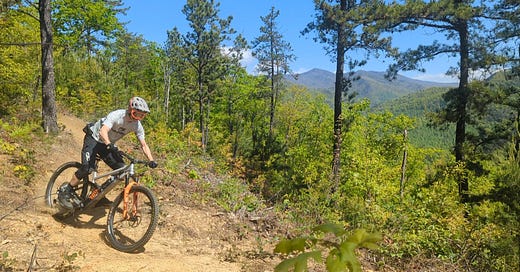





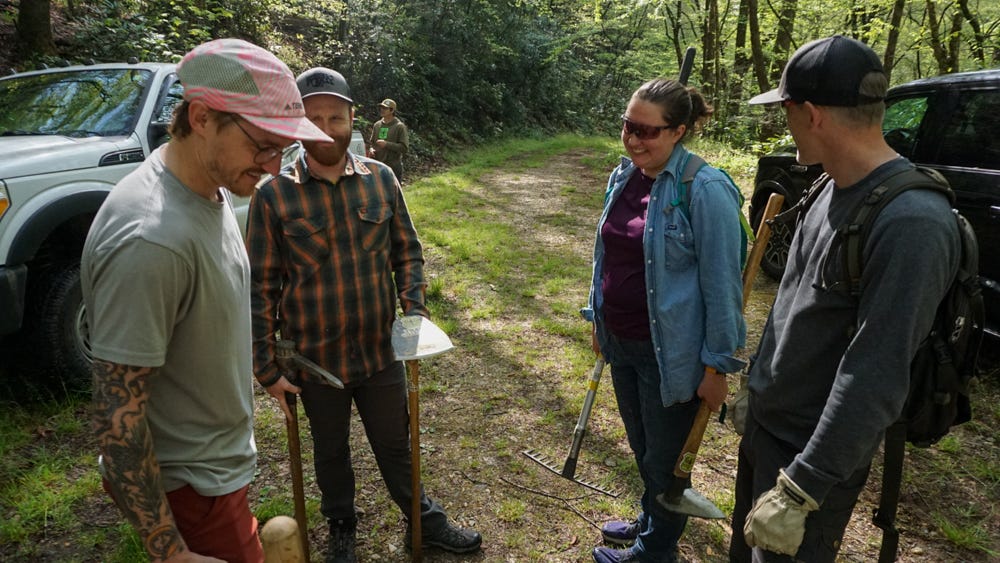

This is a very uplifting article, Kristian. One of the best ways to move forward is to celebrate our successes, and highlight what has been working. Surely anything can be improved upon, but especially here in WNC we're a lot more organized than we once were. Every week I hear about another project that has either begun, been completed, or is in the planning phase.
"In the era of the CCC, trail development followed the tenets of environmental sustainability – the trail should keep users on it and have as little impact on the surrounding land as possible."
This is a bit surprising to me. I expect they'd want the trail to be durable and last, but I'm imagining they wouldn't think much of trampling off trail. Maybe they were way ahead with leave-no-trace though.